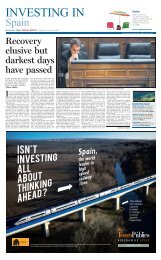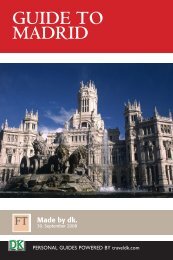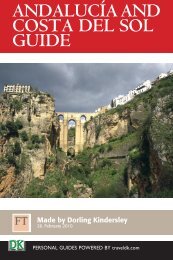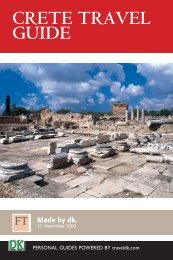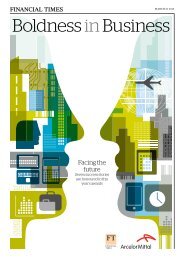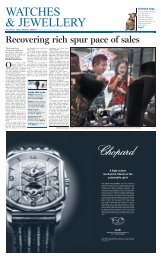Create successful ePaper yourself
Turn your PDF publications into a flip-book with our unique Google optimized e-Paper software.
Berlin Travel Guide<br />
Reichstag<br />
Of all the buildings in Berlin, the Parliamentary Building is probably one of the most symbolic. The mighty structure,<br />
erected in 1884–94 by Paul Wallot as the proud manifestation of the power of the German Reich, was destroyed<br />
by arson in 1933 and bombed during World War II. In 1996, the artist Christo wrapped up the Reichstag and, in<br />
1994–9, the British architect Sir Norman Foster transformed it into one of the most modern parliamentary buildings<br />
in the world. Today it is the official seat of the Bundestag, the German parliament.<br />
Berlin governmental buildings (see Modern Buildings)<br />
Top 10 Sights<br />
1<br />
The Cupola<br />
The new Reichstag cupola by Sir Norman Foster<br />
affords breathtaking views of Berlin. It is open at the top<br />
to air the building and – a touch of irony here – to allow<br />
for the dissemination of debates throughout the country.<br />
A ramp winds its way up to the top.<br />
2<br />
Plenary Hall<br />
The newly designed plenary hall is the seat of the<br />
Deutscher Bundestag, the German parliament, which<br />
has convened here again since 20 April 1999.<br />
Technologically, the hall is one of the most advanced in<br />
the world. The federal eagle caused a row: considered<br />
too “fat”, it had to be slimmed down.<br />
3<br />
Portico “Dem deutschen Volke”<br />
The dedication “To the German People” was<br />
designed in 1916, against the will of Wilhelm II.<br />
4<br />
Restored Façade<br />
Despite extensive renovations, small bullet holes<br />
from World War II are still visible in the building’s façade.<br />
5<br />
Restaurant Käfer<br />
This luxury restaurant next to the cupola on the<br />
Reichstag’s roof offers an excellent view of the historical<br />
centre of Unter den Linden. It is very popular and you<br />
may well have to wait for a seat (see Restaurants &<br />
Cafés) .<br />
6<br />
Installation “Der Bevölkerung”<br />
Hans Haacke’s work of art “To the People” is a<br />
counterpoint to the portico inscription opposite.<br />
7<br />
Memorial by Dieter Appett<br />
Unveiled in 1992, the memorial commemorates 97<br />
Social Democratic and Communist Reichstag delegates<br />
who were murdered under the Third Reich.<br />
8<br />
The German Flag<br />
The giant German flag was first raised on the<br />
occasion of the official national celebrations of German<br />
reunification on 3 October 1990.<br />
9<br />
Platz der Republik<br />
Celebrations often take place on the lawn in front<br />
of the Reichstag, most recently in 1996, when the<br />
building was wrapped up by Christo.<br />
traveldk.com<br />
10<br />
Memorial for Victims of the Wall<br />
Opposite the southern side of the Reichstag, a<br />
memorial recalls the Berlin Wall, which ran only a few<br />
steps away from this spot. One of the crosses<br />
commemorates Chris Gueffroy: shot in February 1989<br />
when trying to escape, he was one of more than 100<br />
people who died at the Wall.<br />
Reichstag<br />
Practical information<br />
• Platz der Republik 1<br />
• Map F3, K2<br />
• Open 8am–midnight<br />
• (030) 22 73 21 52<br />
• www.bundestag.de<br />
Top tips<br />
• If a meal at the Käfer restaurant exceeds your<br />
budget, many stalls in the vicinity of the Reichstag<br />
sell hot dogs.<br />
• Large numbers of visitors come to see the<br />
Reichstag cupola. It is best to avoid weekends or<br />
to start queuing half an hour before the opening<br />
time. Tuesday is the quietest day.<br />
The Reichstag Fire<br />
When the Reichstag went up in flames on 27<br />
February 1933, the Dutch Communist van der<br />
Lubbe was arrested and charged with arson. It is,<br />
however, much more likely that the Nazis had<br />
started the fire themselves. Adolf Hitler used the<br />
Reichstag fire as a pretext to get the “Enabling<br />
Act” passed by parliament. This allowed him to<br />
dispose of all his opponents, marking the beginning<br />
of a 12-year reign of terror.<br />
5<br />
Highlights




